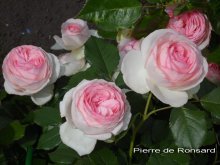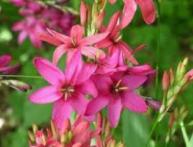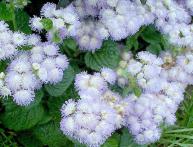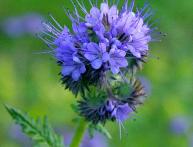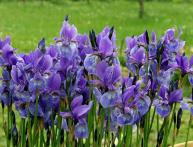Rose Pierre de Ronsard, description, characteristics of the variety and proper planting
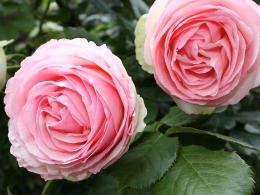
There are flowers that become popular as a tribute to fashion. And there are those that belong to classic garden flowers. They stand above momentary popularity. Roses are always at the top of the list of floral classics. In modern floriculture there are both old roses and many new hybrids and varieties.
As a rule, they are given unusually beautiful and poetic names. And sometimes they are named after the most famous representatives of the poetic elite. Rose Pierre de Ronsard got its name in honor of the French medieval poet and literary figure Pierre de Ronsard. Let's try to figure out what this variety looks like and what makes it remarkable.
Content:
- Description of rose variety Pierre de Ronsard
- How to plant a climbing rose variety Pierre de Ronsard
- How are light rose petals used in folk medicine?
Description of rose variety Pierre de Ronsard
As mentioned above. The variety got its name in honor of the French poet of the Renaissance. K. Strobel, an employee of the German branch of the French company Meilland, which grows roses in all corners of the world, proposed to perpetuate his memory.
This was associated with the four hundredth anniversary of the poet and occurred in 1985. Today this is one of the most successful varieties of climbing roses. Its flowers are very large and densely double. The number of petals exceeds 60.
The diameter of one flower is not less than 7 - 8 cm.The first flowers are especially large, their size is 12 cm. The color of the petals is delicate, creamy-white, turning into a pink edging. The intensity of the pink color sometimes varies. The aroma is very subtle, sometimes slightly perceptible.
The size of the bush is average, shoots They are characterized by slow growth, so rose bushes of Pierre de Ronsard reach their greatest decorative value after three years of age. The leaves are hard. The leaf blades are large and bright green. Thorns are present on the shoots in small quantities. Flowers appear in waves, the first bloom being the most abundant. Repeated blooms are more modest, the flowers open smaller.
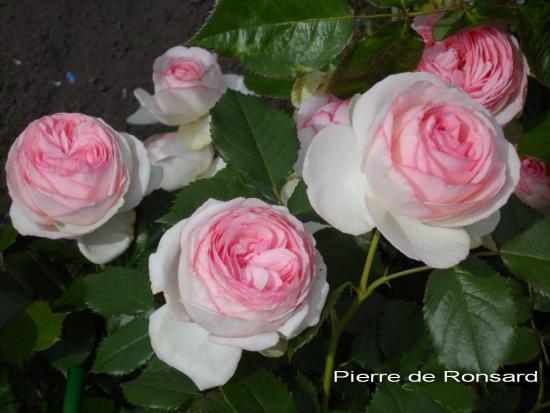
Reviews from rose lovers say that the advantage of the variety is not only its beauty, but also its very high tolerance to almost all pests and diseases of roses. Despite its high decorative value, the climbing rose of this variety was bred for the warm Mediterranean climate. This is associated with almost continuous flowering, the flowers open one by one and do not lose their aesthetic appearance for a long time, even rain and wind do not harm them.
They bloom from the second half of June almost until frost. Of course, roses of this variety feel best in the southern regions. In the middle zone and in the north, flowers may not have enough heat. In this case, the buds will remain under-opened, and the outer petals, instead of a cream color, remain greenish. Also, in cold winters, Pierre de Ronsard rose bushes can freeze and even die if the winter is very harsh. Let's try to find out about some features growing this variety of roses.
How to plant a climbing rose variety Pierre de Ronsard
When choosing a place for a climbing rose, you must first take into account its purpose in the garden.First of all, despite the rather slow growth in the first three years after planting, without pruning the height of the bushes can reach 3 m. Therefore, the bush will need vertical support, this can be a garden gazebo or any other wall, arch or even a fence. It is important that the rose is well lit by the sun and that the same fence does not create a shadow for it.
The second condition for the successful growth of a climbing rose is constant air movement. When rose plantings are well ventilated, the plants feel better. However, the place should still not be in a draft. The best soil for roses is loose sandy loam or loamy soil. The time for planting is spring, after complete thawing and warming of the soil.
Usually this period begins in the second half of May. Before planting, the site must be prepared in advance:
- dig on the bayonet of a shovel
- all weeds and their residue are removed
- dig a planting hole
- fill it with humus in the amount of 1/2 bucket
- moisturize well
After that seedling is installed in a hole, its roots are covered with earth. After which watering is carried out. Care must be taken to prevent erosion of the soil and exposure of roots. The above-ground parts of the rose stems are shortened after planting. Leave no more than 15 - 20 cm.
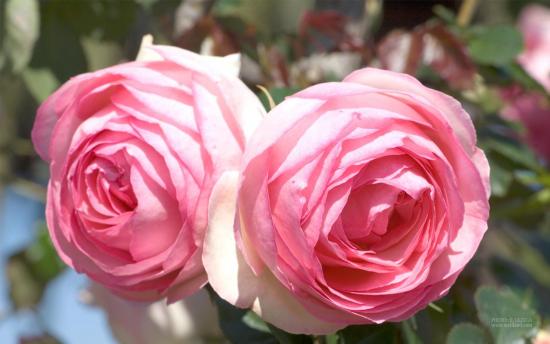
Immediately after planting, the climbing rose needs to be watered. It is held early in the morning. Water pours under the root; it should not fall on the ground part of the shoots. It is especially difficult to cover the Pierre de Ronsard rose for the winter. Although some sources indicate frost resistance down to -30, it is still better not to take risks.
The difficulty is that the shoots of this variety are very tough and it is almost impossible to bend them.Therefore, vertical shelter using a covering material, for example, Lutraxil, is most often used. The bushes are first tied with spruce branches. Sometimes, if size allows, a kind of house is built over the rose bush from old boards, and then covered with insulation.
It turns out that you can also get benefits from the Pierre de Ronsard rose, in addition to aesthetic pleasure.
How are light rose petals used in folk medicine?
Infusion of petals roses an excellent anti-inflammatory agent. For throat diseases, it is enough to brew three tbsp. spoons of dry petals in 0.5 liters of water and gargle with this infusion so that the disease goes away in 2 - 3 days. Bedsores and purulent wounds are treated with an ointment of 1 - 2 g of dry petals and 100.0 g of melted butter.
In addition, an infusion or ointment of white petals helps with necrosis, abscesses and radiation damage to the skin. For chronic respiratory diseases, rose petals are used for inhalation. In conclusion, it must be said that rose Pierre de Ronsard is so beautiful that the variety has repeatedly received top awards at various international competitions.
Video review of rose Pierre de Ronsard:

